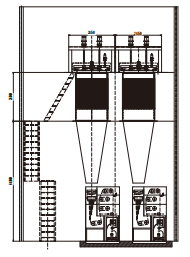Introduction
When selecting materials for food packaging, it’s important to understand the differences between the various types of plastics available. CPET (Crystallized Polyethylene Terephthalate) and APET (Amorphous Polyethylene Terephthalate) are both types of polyethylene terephthalate (PET) commonly used in packaging. Though they share some similarities, each material offers distinct advantages depending on the application. At Jwell, we understand how critical it is to choose the right material for specific packaging needs. This article explores the key differences between CPET and APET, helping you make informed decisions about which material is best suited for your packaging requirements.
What is the difference between CPET and APET?
APET is an amorphous form of PET, meaning its molecular structure is not arranged in a regular pattern. This gives APET its transparent, glossy appearance and flexibility. It is commonly used in food packaging such as trays, clamshells, and containers that need to showcase the product inside. APET is highly versatile and has a broad range of applications due to its excellent clarity, ease of processing, and cost-effectiveness.
In contrast, CPET is a crystallized version of PET. The crystallization process changes the molecular structure of the material, making it more rigid and heat-resistant. CPET containers are ideal for products that will be exposed to both freezing and reheating, such as frozen meals, microwave-safe trays, and oven-ready food packaging.

Key Differences Between CPET and APET
Heat Resistance
One of the most significant differences between CPET and APET is their heat resistance. CPET, due to its crystalline structure, can withstand higher temperatures than APET. CPET can endure temperatures ranging from -40°C to +220°C, making it suitable for both freezing and reheating in ovens or microwaves. This makes CPET an ideal choice for oven-safe or microwave-safe food packaging.
APET, on the other hand, is an amorphous material, meaning it lacks the same thermal stability as CPET. APET typically has a lower heat tolerance and starts to lose its shape at temperatures around 60°C to 70°C. Therefore, APET is not suitable for applications that involve high-temperature exposure, such as reheating in an oven or microwave.
Durability and Rigidity
CPET is significantly more rigid and durable compared to APET. The crystallization process makes CPET containers stronger, allowing them to maintain their shape and structural integrity even when subjected to extreme temperatures. This increased rigidity makes CPET a reliable choice for packaging products that need to withstand both physical stress and high heat, such as frozen meals and ready-to-eat foods.
APET, being more flexible, is less durable than CPET and may not maintain its shape under extreme conditions. It is better suited for packaging that does not require heat resistance or high rigidity, such as transparent trays, clamshells, and other food products that benefit from clarity and flexibility.
Transparency and Aesthetic Appeal
APET is naturally transparent, offering a clear view of the contents inside. This feature is highly desirable in packaging applications where product visibility is important, such as for fresh produce, bakery items, and ready-to-eat meals. APET’s high clarity and glossy finish enhance the aesthetic appeal of the packaging, making it an attractive option for retail displays.
In contrast, CPET is usually semi-opaque or opaque due to the crystallization process. While this reduces its aesthetic appeal compared to APET, the opacity of CPET containers helps protect the food from light and UV radiation, which can degrade the quality of certain food products. The reduced transparency also helps provide a stronger barrier for maintaining freshness and prolonging shelf life.
Applications
APET is widely used in applications that require clarity and flexibility. It is commonly used for packaging fresh foods, such as:
Fresh produce like fruits and vegetables
Bakery items such as cakes, cookies, and pastries
Prepared salads and other food items that are not exposed to high temperatures during use
CPET, on the other hand, is better suited for applications where temperature resistance and rigidity are essential. It is commonly used for:
Frozen meals that need to be stored at low temperatures and then reheated in the microwave or oven
Ready-to-eat meals that require both freezing and reheating
Oven-safe trays for various types of prepared foods
Takeaway food containers that need to endure both freezing and high-temperature cooking
Recyclability
Both CPET and APET are recyclable, but there are differences in the ease of recycling. APET is widely accepted in recycling programs and is easier to process because of its amorphous structure. It is often recycled into new products, including packaging and textiles.
CPET, while also recyclable, is less commonly processed in some recycling facilities due to its crystallized structure, which can make it more difficult to recycle than APET. However, CPET is still considered a sustainable option, especially since it is made from recycled PET (rPET) in many cases, reducing the environmental impact.
Conclusion
In summary, CPET and APET are both variations of polyethylene terephthalate, but they have distinct differences that make them suited to different packaging needs. CPET is more rigid, heat-resistant, and ideal for food packaging that will be exposed to both freezing and high temperatures, such as frozen meals and microwave-safe trays. APET, with its transparency and flexibility, is best for applications that prioritize clarity and cost-effectiveness, such as fresh food packaging and retail displays.
Choosing between CPET and APET depends on the specific requirements of your product. If you need packaging that can withstand high temperatures and maintain structural integrity under stress, CPET is the ideal choice. If you require packaging that offers excellent product visibility and flexibility, APET would be the better option.


















